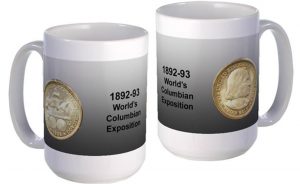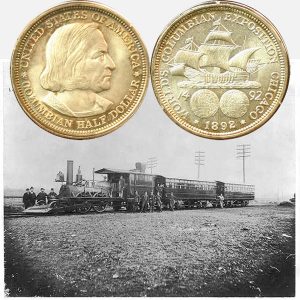Today, the World’s Columbian Exposition Commemorative Silver Half Dollar Coin remembers when the original “John Bull” came out of the museum and traveled the rails again from New York to Chicago beginning April 17, 1893.
From the American Engineer and Railroad Journal of May 1893:
=====
The “John Bull.”
The Pennsylvania Railroad Company issued invitations recently which read as follows:
“The original John Bull locomotive and train of cars will run from New York to Chicago, over the Pennsylvania Railroad, April 17-22, 1893. Mr. ——, you are respectfully invited to accompany the party from —— to ——.
“George W. Boyd,
“Assistant General Passenger Agent.”
On the back of the card was published a schedule of the John Bull train from New York to Chicago. The leaving time from New York was 10 a.m., April 17, and the time of arrival at Chicago was 3.30 p.m. on April 22.
At the time appointed a goodly company, consisting largely of newspaper men, assembled in the station of the Pennsylvania Railroad in Jersey City.
The train consisted of two of the old cars and the veritable John Bull, which had been put into running condition recently.
The engineer was Albert Herbert, who ran the engine in 1847.
The conductor was W. T. Bailey, who began his career as conductor on the old Camden & Amboy Road in 1858, and had been in the service of the Company for 35 years. During that time he never had a passenger injured on any of his trains, and was never suspended nor reprimanded nor subjected the Company to any cost whatsoever on account of accidents.
The John Bull was on exhibition at the Centennial Exhibition in Philadelphia in 1876. and at that time the following description was published by the Pennsylvania Railroad Company, and had a wide circulation:
“The locomotive John Bull was built by Messrs. George & Robert Stephenson, at Newcastle-upon-Tyne, England, for the Camden & Amboy Railroad & Transportation Company in the year 1831.
“It arrived in Philadelphia in August, 1831, and was transferred to Bordentown, N. J., on September 4, 1831.
Original Dimensions.
“Cylinders, 9 in. diameter by 20 in. stroke. One pair of driving-wheels, 4 ft. 6 in. diameter. One pair of wheels, 4 ft. 6 in. diameter, not coupled. Hubs of wheels were of cast iron, the spokes and rims of the wheels of wood. Tires of wrought iron, the weight about 10 tons.
“On arrival at Bordentown it was transferred from the sloop in which it had been brought from Philadelphia by means of wagons to the only piece of permanent track of the Camden & Amboy Railroad Company then completed, and about three-quarters of a mile in length, and about one mile distant from Bordentown.
“The machinery was then put together, and a tender constructed from a whiskey hogshead placed on a four- wheeled platform car, which had been used by the contractor in the construction of the road. The connection between the pump of the locomotive and the tank was made by means of a leather hose fitted up by a shoemaker in Bordentown.
“The locomotive was first put in steam, September 15, and several trial trips were made before the first public trial, on the 12th day of November, 1831, Isaac Dripps acting as engineer, Benjamin Higgins as fireman, and R. L. Stevens as general instructor and conductor. The members of the New Jersey Legislature and a number of other prominent persons were among the guests present.
“The John Bull remained at Bordentown until the year 1833, when the Camden & Amboy Railroad Company began running their cars by steam power, the road having been previously operated with horses. It was then placed on the road, doing the regular routine service, and continued in successful operation until 1866.”
But little can be added to this description at the present time.
The two cars were in marked contrast with those at present in use. The seats were a very old-fashioned pattern, and candor compels us to say were very uncomfortable.
Evidently when they were made the anatomy of the human form had not been studied with as much care as it has been since by some of the designers of modern seats.
The backs of the passengers were supported only at the shoulder blades. Their spinal columns received no attention in those early days of railroading.
The car had an old-fashioned arched roof, without ventilators or windows in it. The height of the floor to the eaves inside was 5 ft. 8 in. ; the height of the center was 6 ft. 5 in. The ceiling was therefore destructive to plug hats worn by tall men.
The windows consisted of two panes of glass each 8.5 X 9.5 in. Between these was a wooden panel 17 X 21 in., which was arranged to lower like the window in an ordinary carriage. The windows themselves were fixed and could not be moved.
Above the windows and panels and extending the whole length of the car were a series of pneumonic ventilators. Daylight could be seen through the crevices around almost any of them, and was very suggestive of uncomfortable drafts in cold weather.
Small blue curtains were looped up over the windows, and resembled those used in children’s play-houses.
The appliance for lighting the car consisted of a tallow candle in a sort of lantern on each end.
That which impressed the passengers on these cars was their extreme rigidity or the roughness of their movement on the track of the Pennsylvania Railroad. In recollecting the early days of traveling, one is apt to attribute the jolting to the rough roads of those early days, but even on the permanent way of the Pennsylvania Railroad these old cars were very uncomfortable.
One feature which attracted attention on the old engine was a sort of a buggy-top on the back end of the tender, which faces toward the rear end of the train.
The history of this appliance is that in 1855 a very serious accident happened on the old Camden & Amboy Railroad at Burlington.
A passenger train was there backing down over a road crossing, and ran into a carriage and pair of horses belonging to a Dr. Hanagan. The rear car was thrown off the track and the other cars crushed into one another, killing and wounding a large number of passengers.
The buggy-top arrangement was then placed on all the tenders, and a lookout was stationed there whenever passenger trains were backed up.
Immense crowds were collected at all the stations between New York and Philadelphia, and the interesting feature was that the arrival of the train was greeted with a broad smile on the faces of each one of the spectators.
The general verdict of all passengers on this excursion was that they preferred modern cars to those of the early days.
=====
The World’s Columbian Exposition Commemorative Silver Half Dollar Coin shows with an image of the original “John Bull” locomotive, circa 1893.

